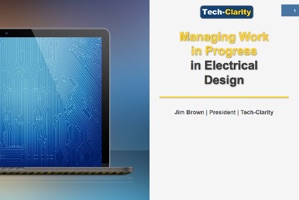The Managing Work in Progress in Electrical Design ebook shares best practices for managing electrical engineering data, designs, and processes. The research explains the role that Electronic Data Management (EDM) plays alongside other solutions including PDM, ALM, and PLM that manage mechanical CAD, software development, and the overall product development process respectively. EDM plays a parallel role with PDM to manage ECAD and electrical engineering workflows, helping coordinate data and processes across teams of electrical engineers. The eBook shares how this helps reduce wasted, non-value-added time in electrical engineering, assists engineers in selecting the optimal components, and promotes reuse among other benefits.
Please enjoy the summary below.
Please visit our sponsor Cadence for the full eBook (free of charge, registration required).
Too Much Waste in Electrical Design
 Engineers are the engines of product innovation. Their efforts turn product dreams and concepts into reality and, maybe most importantly, into company profits. Most companies recognize that their engineers need the right tools to get their work done. They enable them with a range of specialty tools for different aspects of design, analysis, and simulation. These are high-value solutions that help people design things that would be practically unachievable by more manual methods.
Engineers are the engines of product innovation. Their efforts turn product dreams and concepts into reality and, maybe most importantly, into company profits. Most companies recognize that their engineers need the right tools to get their work done. They enable them with a range of specialty tools for different aspects of design, analysis, and simulation. These are high-value solutions that help people design things that would be practically unachievable by more manual methods.
Why then, is there so much inefficiency in engineering? Our research, Reducing Non-Value-Added Work in Engineering, finds that technical resources spend about one-third of their time on non-valued-added (NVA) activity. The most significant portion of wasted time is spent simply searching for the information they need to do their jobs. For electrical engineering, too much time is lost searching for parts, looking up specs, waiting for data, reworking designs because of bad libraries, or resolving problems that other design teams already solved on an earlier design.
Beyond accessing the data they need, engineers spend a tremendous amount of time keeping work-in-progress (WIP) designs and processes under control. Or, perhaps worse, they waste time fixing problems resulting from poor control. These activities cost engineers, and their companies, significant time and money. More importantly, they slow the pace of innovation resulting in poor efficiency, excess cost, and late products. Engineers are constantly forced to take data management shortcuts in order to maintain schedule, mortgaging future gains in productivity to meet pressing deadlines.
Conclusion
Today’s competitive global markets demand high levels of productivity. Over one-half of companies, however, suffer from design inefficiency due to data management challenges, according to our The Facts about Managing Product Data research. Companies can no long afford that level of NVA effort in engineering. It’s time to move away from informal methods that lead to errors and rework, and adopt disciplined methods to control, access, and share WIP electrical design data. This approach also helps engineers manage their processes and collaborate across electrical design disciplines.
 EDM is a critical element of the enterprise ecosystem. It integrates with PLM and ERP to provide the detailed WIP support needed for electrical designs in the context of an overall product innovation process. Electronic EDM is the missing element that gives electrical engineers the tools they need to be efficient and effective and get away from today’s high levels of NVA time. As a result, engineering can reduce non-value-added work, improve quality, reduce risk, and speed up design cycles and time to market.
EDM is a critical element of the enterprise ecosystem. It integrates with PLM and ERP to provide the detailed WIP support needed for electrical designs in the context of an overall product innovation process. Electronic EDM is the missing element that gives electrical engineers the tools they need to be efficient and effective and get away from today’s high levels of NVA time. As a result, engineering can reduce non-value-added work, improve quality, reduce risk, and speed up design cycles and time to market.
Electrical EDM helps manufacturers:
- Enable cross domain collaboration
- Drive real-time design and project visibility throughout the organization
- Manage WIP electrical design data without adding extra work steps
- Enable agility in electrical engineering workflows
- Efficiently find and reuse information when it’s needed
- Control, access, and share components
- Optimize technical and business needs via Strategic Parts Lists
- Control the engineering design, not just manage files
- Establish and implement best practice processes for design projects
*This summary is an abbreviated version of the report and does not contain the full content. A link to download the full report is available above.
If you have difficulty obtaining a copy of the report, please contact us using the “Contact” link below.

